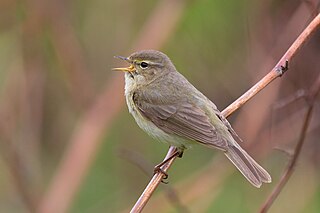
The American goldfinch is a small North American bird in the finch family. It is migratory, ranging from mid-Alberta to North Carolina during the breeding season, and from just south of the Canada–United States border to Mexico during the winter.

The myna is a bird of the starling family (Sturnidae). This is a group of passerine birds which are native to southern Asia, especially India, Pakistan and Bangladesh. Several species have been introduced to areas like North America, Australia, South Africa, Fiji and New Zealand, especially the common myna which is often regarded as an invasive species. It is often known as "Selarang" and "Teck Meng" in Malay and Chinese respectively in Singapore, due to their high population there.

The common chiffchaff, or simply the chiffchaff, is a common and widespread leaf warbler which breeds in open woodlands throughout northern and temperate Europe and the Palearctic.

The common myna or Indian myna, sometimes spelled mynah, is a member of the family Sturnidae native to Asia. An omnivorous open woodland bird with a strong territorial instinct, the common myna has adapted extremely well to urban environments.

The angle of repose, or critical angle of repose, of a granular material is the steepest angle of descent or dip relative to the horizontal plane to which a material can be piled without slumping. At this angle, the material on the slope face is on the verge of sliding. The angle of repose can range from 0° to 90°. The morphology of the material affects the angle of repose; smooth, rounded sand grains cannot be piled as steeply as can rough, interlocking sands. The angle of repose can also be affected by additions of solvents. If a small amount of water is able to bridge the gaps between particles, electrostatic attraction of the water to mineral surfaces will increase the angle of repose, and related quantities such as the soil strength.

The desert locust is a species of locust, a periodically swarming, short-horned grasshopper in the family Acrididae. They are found mainly in Africa, through Arabia and West Asia, and extending into parts of South Asia. During population surge years, they may extend into parts of western Spain. The desert locust shows periodic changes in its body form and can change, in response to environmental conditions, over generations, from a solitary, shorter-winged, highly fecund, nonmigratory form to a gregarious, long-winged, and migratory phase in which they may travel long distances into new areas. In some years, they may thus form locust plagues, invading new areas, where they may consume all vegetation including crops, and at other times, they may live unnoticed in small numbers.

The antlions are a group of about 2,000 species of insect in the family Myrmeleontidae, known for the fiercely predatory habits of their larvae, which in many species dig pits to trap passing ants or other prey. The adult insects are less well known, due to their relatively short lifespans compared to the larvae. Adults mostly fly at dusk or after dark, and may be mistakenly identified as dragonflies or damselflies; they are sometimes known as antlion lacewings. In North America, the larvae are sometimes referred to as doodlebugs because of the strange marks they leave in the sand.

The migratory locust is the most widespread locust species, and the only species in the genus Locusta. It occurs throughout Africa, Asia, Australia and New Zealand. It used to be common in Europe but has now become rare there. Because of the vast geographic area it occupies, which comprises many different ecological zones, numerous subspecies have been described. However, not all experts agree on the validity of some of these subspecies.

Euroleon nostras is a species of antlion found over most of Europe. The scientific name can be translated as "our European [ant] lion". Adults resemble dragonflies or damselflies and may reach up to 30 mm (1.2 in) long, with a wingspan of 70 mm (2.8 in). The larvae prey on ants and other small creatures and require dry sandy soil in which to dig their pitfall traps.

The Brachyceran family Vermileonidae is a small family of uncertain affinities and unusual biology. It includes fewer than 80 described species, most of them rare and with restricted distribution, in 10 genera. Historically the vermileonids had been regarded as belonging to the family Rhagionidae, possibly in a subfamily Vermileoninae. Their biology and morphology is so markedly distinct from the main Rhagionidae sensu stricto however, that the placement as a separate family has been widely accepted.

Ambush predators or sit-and-wait predators are carnivorous animals that capture or trap prey by stealth, luring or by strategies utilizing an element of surprise. Unlike pursuit predators, who chase to capture prey using sheer speed or endurance, ambush predators avoid fatigue by staying in concealment, waiting patiently for the prey to get near, before launching a sudden overwhelming attack that quickly incapacitates and captures the prey.

The black-headed monitor or black-tailed monitor is a relatively small species of monitor lizards native to Australia. It is occasionally also called the mournful monitor, freckled monitor or the racehorse monitor, a name it shares with the Gould's monitor due to their exceptional speed. It is placed in the subgenus Odatria.

Although projectiles are commonly used in human conflict, projectile use by organisms other than humans is relatively rare.

Calliptamus italicus, the Italian locust, is a species of 'short-horned grasshopper' belonging to the family Acrididae, subfamily Calliptaminae.

In Africa, the little five game animals are:

Hagenomyia tristis is an African antlion species. It is known as the gregarious antlion as it is often found in swarms in long grass in the shade of trees. The range of this species extends from eastern South Africa to Cameroon and Ethiopia; it is also found in Madagascar. The larvae build sand pit traps to capture prey. This species is believed to be the mimic of Banyutus lethalis, with both species commonly swarming together.

Hagenomyia is a genus of antlions (Myrmeleontidae) containing around 20 species occurring in Eastern Asia, tropical Africa and Australia.
Scaptia muscula is a large horse fly native to Australia.

Centroclisis is a genus of antlions (Myrmeleontidae) with about 56 species occurring in Africa and Asia. They are known as bark antlions - during the day they rest on the bark of trees, with their wings flattened. At night they may be attracted to lights.
Banyutus is a genus of antlions belonging to the family Myrmeleontidae.


















